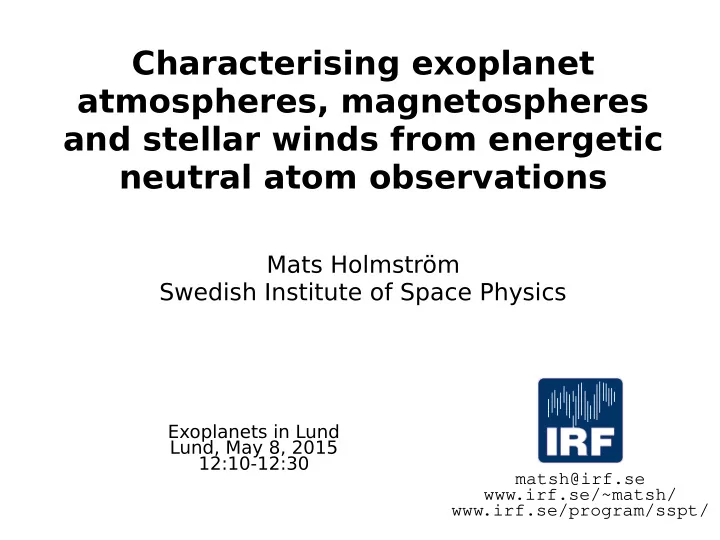

Characterising exoplanet atmospheres, magnetospheres and stellar winds from energetic neutral atom observations Mats Holmström Swedish Institute of Space Physics Exoplanets in Lund Lund, May 8, 2015 12:10-12:30 matsh@irf.se www.irf.se/~matsh/ www.irf.se/program/sspt/
Overview ● Energetic neutral atom (ENA) imaging ● Basic principles ● ENAs from the solar wind interaction with ● Mars ● Venus ● Earth ● The Moon ● Exoplanet ENAs ● Observations ● Models
Energetic Neutral Atoms (ENA) [Wurz, 2000] Here we focus on the energy range: 1 eV - 10 keV
ENA Properties ● Straight line trajectories Unaffected by electromagnetic fields, or gravity ● Can be imaged by a detector ● Produced by ● Charge exchange ● Sputtering
Solar wind interactions [Kivelson and Russel]
Planetary ENA Experiments (outside Earth) 7
Earth Ring current ENAs
ENA Production at Mars ● Generated by ● Solar wind-exosphere charge exchange ● Atmospheric sputtering and backscatter (of precipitating ions and ENAs) ● Planetary ions-exosphere charge exchange ● Three-dimensional emissions
ENA Imaging of Non-Magnetized Planets [C:son Brandt]
Mars Express ENA imager Field of View [Futaana, 2004]
Mars [Galli et al., JGR, 2008]
Subsolar ENA jet at Mars observed by ASPERA-3 [Futaana et al., JGR, 2006] Dynamics: Effect of an interplanetary shock
Magnetosheet ENAs at Earth IBEX observations [Fuselier et al., GRL, 2010]
Venus ASPERA-4 on Venus Express Observation MHD Model [Galli at al., JGR, 2008]
ENA Production at the moon Generated by sputtering from Micro meteoroid impact vaporization Photon desorption Precipitating Magnetospheric ions Solar wind ions Significant contribution only from precipitating solar wind ions T wo-dimensional emissions
SARA on Chandrayaan-1 [Futaana et al., 2004]
The Moon reflects the solar wind [Wieser et al., PSS, 2009] Observation by SARA on Chandrayaan-1: ~20% of the solar wind protons are reflected by the Moon as neutral H.
Reflected spectrum [Wieser et al., PSS, 2009]
First direct observation of a mini-magnetosphere Hydrogen Energetic Neutral Atoms (ENAs) from precipitating solar wind protons
Exoplanet ENAs? ● Transit Lyman-alpha observations ● Direct observation of hot hydrogen ● Local observation of the exoplanet environment [Vidal-Madjar et al., Nature, 422, 2003]
Model of Hot Jupiter ENA Production [Holmström et al., Nature, 2008]
Comparison with observation Using typical solar wind parameters, and [Ekenbäck, ApJ, 2010] published atmospheric parameters
Recent HD 209458b model
Conclusions ● Energetic neutral atoms (ENAs) have been observed throughout the solar system ● They should be produced also in other planetary systems from the interaction between exoplanets and stellar winds ● Lyman-alpha observations give us the possibility to observe these ENAs ● Energetic Neutral Atoms (ENAs) contribute to the observed Lyman α absorption ● Stellar wind, atmospheric, and magnetospheric properties could be inferred from Lyman α observations through ENAs ● Plasma processes should be considered in exoplanet investigations
Recommend
More recommend